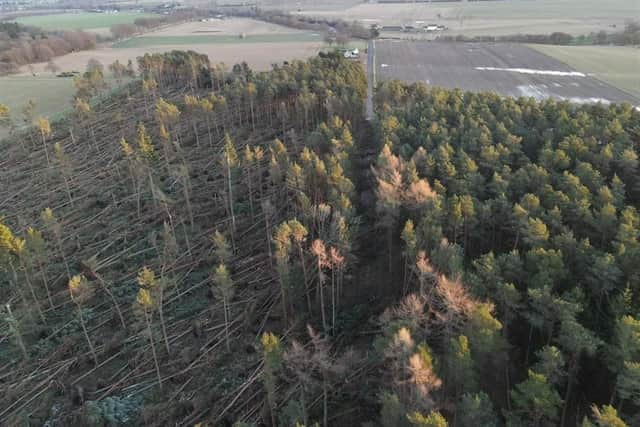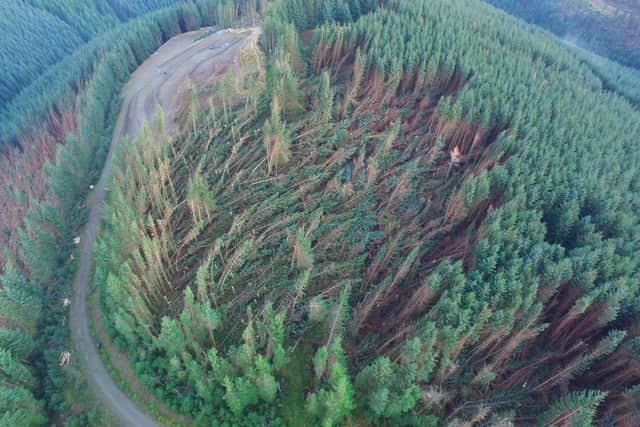Sustainable Scotland: Diverse forests and native trees key to resilience against violent storms amid climate crisis
Analysis by the Forest Research agency has revealed that around 9,300 hectares of woodland were damaged as a result of three major storms which struck Scotland – Arwen, which blew in at the end of November 2021, then Malik and Corrie, which followed in January this year.
Estimates suggest around 18.6 million trees – equating to two million cubic metres of commercial timber – were affected.
Advertisement
Hide AdAdvertisement
Hide AdNow, as foresters continue to count the environmental and economic costs of the fierce weather, they say many lessons have been learned that should be used when replanting woodlands to withstand the increasingly extreme weather expected as climate change continues to take its toll.
To create the maximum resilience to strong winds, forests must be diverse – featuring a mixture of species of different ages and sizes. The move would be a major step change away from the forestry plantations of the past, which comprise vast swathes of monoculture conifers of uniform height.
“We’ve not encountered storms as vicious as Arwen for many years, and its effects were quite devastating for many woodland owners,” said Jason Hubert, head of business development at Scottish Forestry. “The direction and ferocity of the wind meant many trees were simply not able to withstand the onslaught.
“With climate change having negative impacts on future weather patterns we can probably expect windier and wetter winters. We need to create more diverse forests with different species, sizes and age so that they can handle extreme weather events better. This will take time but we can plan our future forests now.”
Meanwhile, new research shows that most Scots would like to see native trees at the heart of the nation’s forestry strategy and a move away from traditional commercial planting.


A poll commissioned by Scottish Environment Link, a coalition of charities, found that four out of five members of the public believe the focus should be on indigenous woodlands while only one in 10 think policy should prioritise the imported species often grown for timber.
The Scottish Government has announced a planned refresh of the Forestry Grant Scheme, with a consultation expected early next year. Environment minister Mairi McAllan said the updated scheme would support targets to expand forests, while tackling loss of nature and climate change.
Link members are calling for the grant scheme to do more to support biodiversity in woodlands and provide greater benefits for communities.
Advertisement
Hide AdAdvertisement
Hide AdAlan McDonnell, conservation manager at Trees for Life and convener of Link’s Woodlands Group, said: “Scotland’s woodlands are an incredibly important part of our landscapes and natural environment, and have a key role in tackling the twin crises of climate change and nature-loss.


“Targets to plant more trees and regenerate more native woodland are good, but they must truly deliver the right trees in the right places. Commercial forestry has an important part to play, but there is little biodiversity benefit in creating uniform forests dominated by a few species grown commercially and generally clear-felled at harvesting time.
“We need a more thoughtful approach to landscape change that reflects both the climate and nature emergencies, as well as the needs of local communities.”
Arina Russell, policy and advocacy manager at Woodland Trust Scotland, said: “We welcome the Scottish Government’s intention to refresh the Forestry Grant Scheme and do so by consulting the public, which is a huge opportunity for public funding to tackle nature-loss.
“The public overwhelmingly want policy and funding support to focus on native woodlands for nature and people. The Scottish Government can make that happen.
“The Forestry Grant Scheme should reverse the decline in our native woodlands and should offer increased support for natural regeneration, where we can let nature do the work for us. All this is possible while also supporting a thriving and sustainable commercial forestry sector.
“This approach would carry public support, capture carbon long-term and be hugely beneficial for nature.”
Comprehensive guidance on adapting forests to tackle climate change has recently been published, recommending that a wider variety of tree species, natural regeneration and careful seed selection should be factored into design plans to create hardier woodlands.
Comments
Want to join the conversation? Please or to comment on this article.